Table of Contents
Plot
In Cobra Kai Season 1 Episode 2 ,” titled “Strike First,” the rivalry between Johnny Lawrence and Daniel LaRusso intensifies as they both struggle to find their place in the present, haunted by the ghosts of their past. The episode delves deeper into the characters’ backgrounds, providing context for their animosity and shedding light on their current life situations.
The episode kicks off with Johnny trying to resurrect the Cobra Kai dojo and struggling to attract students. Despite his tough exterior, he faces financial challenges and a sense of disillusionment. In a nostalgic nod to the original “Karate Kid” movie, Johnny revisits the old Cobra Kai dojo, reminiscing about the glory days. This sets the tone for his journey to revive the legacy of Cobra Kai.
Meanwhile, Daniel is portrayed as a successful car dealership owner, enjoying the fruits of his labor. However, beneath the surface, he grapples with the absence of a mentor figure in his life, particularly after the passing of Mr. Miyagi. This void becomes more evident as Daniel encounters his daughter’s boyfriend, who exhibits similar reckless behavior to his younger self.
The central theme of “Strike First” revolves around the concept of striking first, a principle ingrained in the Cobra Kai philosophy. Johnny instills this mantra in his first student, Miguel, a teenager facing bullying at school. The dynamic between Johnny and Miguel becomes a focal point as the former imparts his karate wisdom while simultaneously grappling with the ethical implications of his teachings.
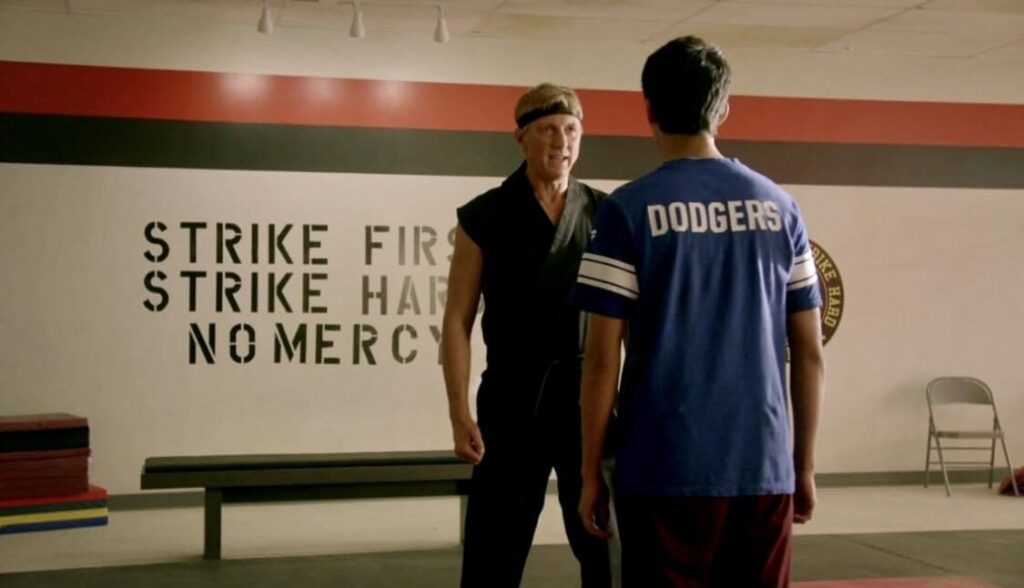
The episode explores the consequences of adopting the “strike first” mentality. Miguel, inspired by Johnny’s teachings, confronts his bullies, resulting in a school altercation. This incident triggers a chain reaction, attracting the attention of both Johnny and Daniel. Their paths cross at the school, reigniting the deep-seated animosity between them.
In a series of flashback sequences, viewers gain insight into Johnny and Daniel’s teenage years. These flashbacks provide a nuanced understanding of their perspectives, humanizing characters who were previously portrayed in a more one-dimensional light. Johnny’s struggles with an abusive stepfather and a challenging adolescence contribute to the layers of his character, while Daniel’s recollections shed light on his own experiences with bullying.
The episode skillfully weaves together past and present, highlighting the cyclical nature of life and the enduring impact of one’s upbringing. As Johnny and Daniel navigate the complexities of adulthood, they are forced to confront their own demons and reassess their understanding of karate’s purpose.
“Strike First” sets the stage for the overarching themes of redemption and second chances, as both Johnny and Daniel grapple with the consequences of their actions. The episode skillfully blends nostalgia with fresh perspectives, appealing to both fans of the original “Karate Kid” franchise and newcomers alike.
In conclusion, Episode 2 of “Cobra Kai” Season 1, “Strike First,” delves into the intricate dynamics between Johnny Lawrence and Daniel LaRusso. Through a masterful blend of flashbacks and present-day events, the episode explores themes of identity, mentorship, and the consequences of one’s actions. As the characters navigate the complex world of karate and personal redemption, “Strike First” lays the foundation for a compelling narrative that resonates with both long-time fans and a new generation of viewers.
Action and Direction
In Episode 2 of “Cobra Kai” Season 1, titled “Strike First,” the action and direction play a crucial role in advancing the storyline and character development. The episode is skillfully crafted to blend intense fight sequences with thoughtful character moments, providing a dynamic viewing experience.
1. Action Sequences:
School Fight: The episode features a significant action sequence at the school where Miguel, inspired by Johnny’s “strike first” philosophy, confronts his bullies. The choreography of the fight is well-executed, showcasing Miguel’s newfound karate skills and the impact of Cobra Kai teachings. It brings a sense of excitement and energy to the episode, establishing the physicality associated with martial arts.
Johnny’s Flashbacks: Flashback sequences to Johnny’s teenage years include action scenes that depict his struggles with an abusive stepfather. These scenes contribute to the understanding of Johnny’s character and showcase the roots of his toughness and resilience.
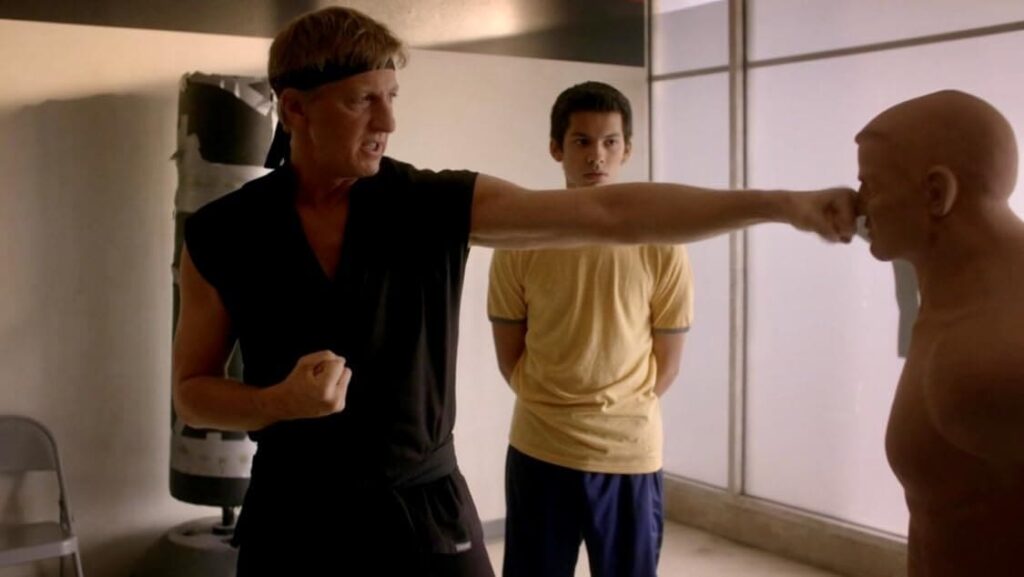
Cobra Kai Training: The training scenes at the resurrected Cobra Kai dojo involve various action elements as Johnny imparts his martial arts wisdom to his first student, Miguel. These sequences highlight the core philosophy of “Cobra Kai” and set the stage for the conflicts to come.
2. Direction:
Nostalgic Elements: The director skillfully incorporates nostalgic elements, particularly in Johnny’s scenes. Visiting the old Cobra Kai dojo and having flashbacks to his youth are directed in a way that connects with fans of the original “Karate Kid” while providing new layers to Johnny’s character.
Parallel Storytelling: The episode seamlessly weaves together the past and the present, using parallel storytelling to draw connections between Johnny and Daniel’s teenage years and their current struggles. This direction enhances the depth of the characters and emphasizes the cyclical nature of their lives.
Emotional Beats: The director effectively captures emotional beats, especially in scenes where Daniel reflects on Mr. Miyagi’s absence and when Johnny grapples with the consequences of his teachings. These moments add a human touch to the characters and elevate the narrative beyond just martial arts action.
Tension Building: As Johnny and Daniel’s paths cross at the school, the direction builds tension, emphasizing the long-standing rivalry between them. The use of camera angles, music, and pacing contributes to the heightened drama of their encounter.
Character Development: The director pays attention to character development, allowing the audience to empathize with Johnny and Daniel through their struggles. Flashbacks are seamlessly integrated into the narrative, providing context without disrupting the flow of the episode.
In summary, the action and direction in Episode 2 of “Cobra Kai” Season 1 enhance the storytelling experience. Well-choreographed action sequences, nostalgic elements, effective parallel storytelling, emotional beats, and attention to character development contribute to the overall success of the episode, keeping viewers engaged and invested in the unfolding narrative.
Character Development
In Episode 2 of “Cobra Kai” Season 1, titled “Strike First,” character development is a key aspect that contributes significantly to the richness of the narrative. The episode delves into the backgrounds of Johnny Lawrence and Daniel LaRusso, providing insights into their pasts and shaping their present-day struggles.
1. Johnny Lawrence:
Flashbacks: The episode opens a window into Johnny’s teenage years through flashbacks, revealing a challenging upbringing with an abusive stepfather. These flashbacks add depth to Johnny’s character, showcasing the tough circumstances that have shaped his personality and choices. Viewers gain a more nuanced understanding of Johnny’s resilience and the origins of his “strike first” mentality.
Financial Struggles: Johnny’s attempt to revive the Cobra Kai dojo highlights his financial difficulties. This aspect of his character adds a layer of realism and relatability, humanizing the once-dominant high school karate champion. It also sets the stage for Johnny’s quest for redemption and a fresh start.
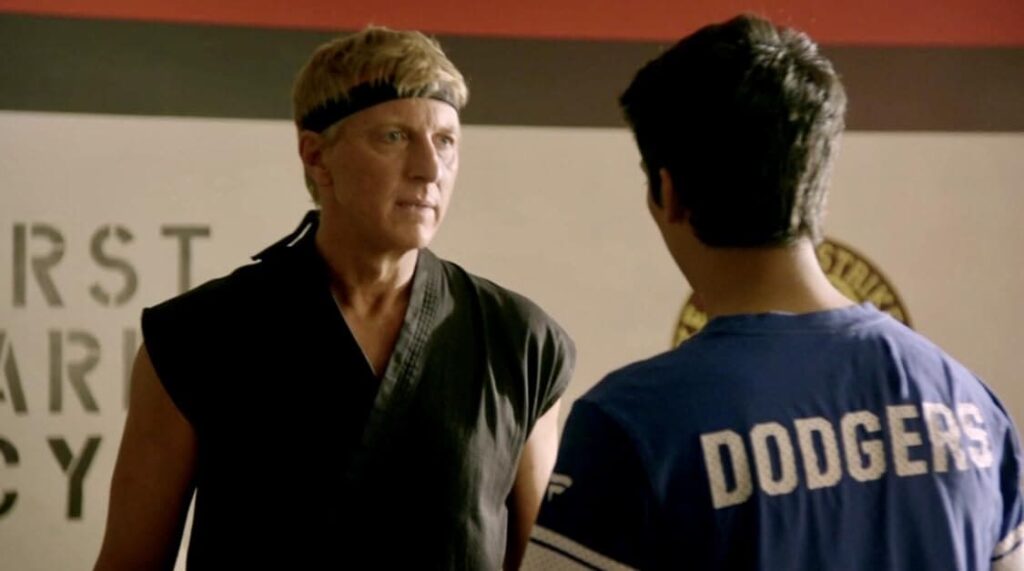
Teaching Philosophy: Johnny’s interactions with his first student, Miguel, demonstrate the evolution of his teaching philosophy. While he imparts the “strike first” mentality, there is a sense of conflict within Johnny as he grapples with the ethical implications of his teachings. This internal struggle foreshadows potential changes in Johnny’s character as the series progresses.
2. Daniel LaRusso:
Business Success: Daniel’s character is portrayed as a successful car dealership owner, enjoying the fruits of his labor. However, beneath the surface, there is a sense of longing for the mentorship he received from Mr. Miyagi. The absence of this guiding figure becomes more apparent as Daniel encounters his daughter’s boyfriend, who mirrors his own teenage recklessness.
Parental Concerns: The episode explores Daniel’s concerns as a parent, especially regarding his daughter’s relationship. This aspect of his character adds a relatable dimension, showing that despite his success, Daniel faces challenges in navigating parenthood. It also connects to the overarching theme of passing down lessons learned to the next generation.
Encounter with Johnny: The rekindling of the rivalry with Johnny brings out different facets of Daniel’s personality. The episode hints at unresolved issues from their past, and Daniel’s reactions to Johnny’s presence reveal the complexity of their relationship. This encounter sets the stage for potential character growth and reconciliation.
3. Miguel:
Bullying and Empowerment: Miguel, the first student of the resurrected Cobra Kai dojo, undergoes significant character development. Miguel’s transformation from a bullied teenager to a confident martial artist is a central arc in the episode, illustrating the impact of Cobra Kai’s philosophy on its students.
Conflict and Morality: Miguel’s involvement in a school fight raises moral questions about the “strike first” mentality. This internal conflict adds complexity to his character, showcasing that the consequences of karate teachings extend beyond physical altercations.
In summary, Episode 2 of “Cobra Kai” Season 1 masterfully develops characters by delving into their pasts, presenting current struggles, and hinting at potential growth. Johnny’s financial challenges, Daniel’s search for mentorship, and Miguel’s empowerment contribute to the multi-layered storytelling that forms the foundation of the series. The nuanced character development sets the stage for compelling arcs and explores the timeless themes of redemption, identity, and the enduring impact of one’s history.
Also read: The Burial (2023) Movie review: A Hauntingly Beautiful Film About Death and Rebirth
Visual effects and cinematography
“Cobra Kai” Episode 2 of Season 1, titled “Strike First,” exhibits skilled visual effects and cinematography, enhancing the storytelling experience with dynamic visuals and effective use of camera work.
1. Visual Effects:
Martial Arts Choreography: The episode features well-executed martial arts choreography, blending physical stunts with visual effects to create impactful fight scenes. The movements are fluid and engaging, contributing to the authenticity of the karate sequences. The visual effects team enhances the intensity of these scenes through dynamic camera angles and seamless integration of action elements.
Flashbacks: Visual effects are employed to transition between the present-day narrative and flashbacks to Johnny’s teenage years. These transitions are smooth and contribute to the storytelling by providing insights into the characters’ backgrounds. The visual effects help establish a visual distinction between past and present, aiding in the audience’s understanding of the narrative timeline.
School Fight Sequence: The school fight sequence involves visual effects to portray the intensity and impact of the confrontations. From kicks and punches to the use of karate techniques, the visual effects enhance the overall excitement of the action, making it visually compelling for the audience.
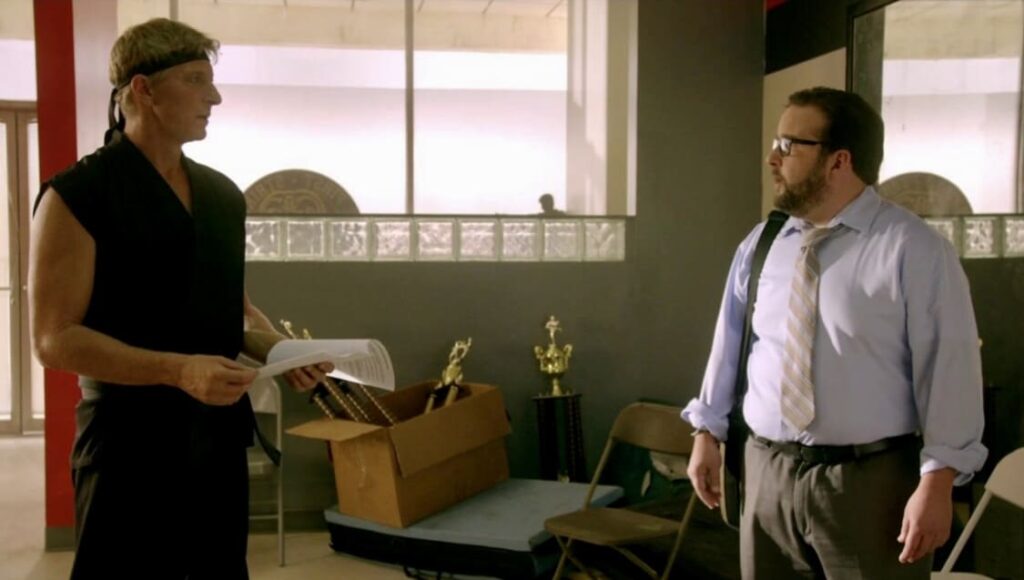
2. Cinematography:
Nostalgic Elements: Cinematography is employed to capture nostalgic elements, especially in scenes where Johnny revisits the old Cobra Kai dojo. The framing and composition of these shots evoke a sense of nostalgia for fans of the original “Karate Kid” while also contributing to the emotional depth of Johnny’s character.
Parallel Storytelling: Cinematography is used to seamlessly weave together parallel storylines, connecting Johnny and Daniel’s teenage years with their present-day struggles. The use of visual cues and framing techniques helps establish the parallels, emphasizing the cyclical nature of their lives and the enduring impact of their pasts.
Tension Building: The cinematography effectively builds tension, particularly in the encounter between Johnny and Daniel at the school. The choice of camera angles, shot composition, and pacing contributes to the suspense and drama of the moment, highlighting the long-standing rivalry between the characters.
Character Moments: Cinematography is employed to capture subtle character moments, such as Daniel’s reflective scenes and Johnny’s internal conflicts. The use of close-ups and framing choices enhances the emotional beats, allowing the audience to connect with the characters on a more personal level.
Training Sequences: The scenes depicting karate training at the Cobra Kai dojo are visually dynamic, with cinematography emphasizing the physicality of the martial arts. The use of wide shots and dynamic camera movements adds energy to these sequences, showcasing the transformation of Miguel as he learns the “strike first” philosophy.
In conclusion, Episode 2 of “Cobra Kai” Season 1 demonstrates strong visual effects and cinematography, elevating the overall viewing experience. The integration of martial arts choreography with visual effects, seamless transitions between timelines, and thoughtful cinematography contribute to the series’ visual appeal. These elements not only enhance the action sequences but also effectively capture the emotional nuances of character development and the nostalgic elements that resonate with fans of the franchise.
World-Building
“Cobra Kai” Episode 2 of Season 1, titled “Strike First,” contributes to the world-building of the series by expanding on the settings, reintroducing familiar locations, and establishing the cultural and philosophical aspects of the martial arts world.
1. Setting and Locations:
Resurrected Cobra Kai Dojo: The episode introduces the audience to the renovated Cobra Kai dojo, emphasizing Johnny’s attempt to revive the once-successful martial arts school. The setting becomes a focal point for the series, symbolizing the resurgence of Cobra Kai and setting the stage for conflicts and character development.
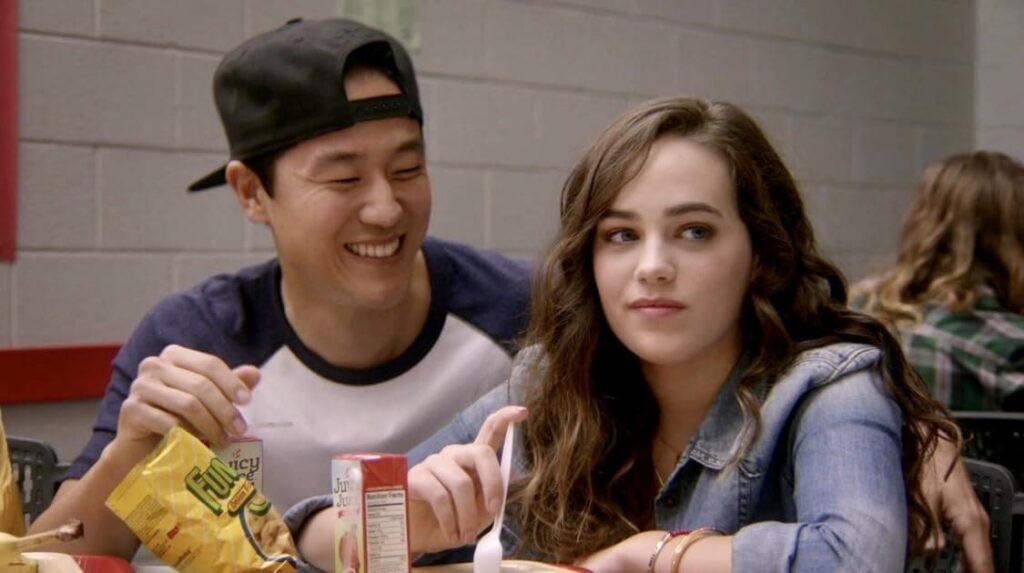
School Environment: A significant portion of the episode is set in the school, where the events of the school fight unfold. This environment becomes a crucial backdrop for the characters’ interactions, highlighting the challenges faced by the students and the impact of martial arts teachings in a school setting.
Flashbacks to Johnny’s Past: The use of flashbacks to Johnny’s teenage years adds depth to the world-building by exploring the character’s background. These glimpses into the past contribute to the overall understanding of the martial arts culture in the “Cobra Kai” universe, showing the origins of Johnny’s involvement in karate and the influence of his sensei.
2. Cultural and Philosophical Aspects:
Cobra Kai Philosophy: The episode delves into the philosophy of Cobra Kai, particularly the concept of “strike first.” This martial arts philosophy becomes a central element of the world-building, shaping the interactions between characters and influencing the narrative direction. The revival of Cobra Kai introduces viewers to a different approach to karate, contrasting with more traditional teachings.
Legacy of Mr. Miyagi: The absence of Mr. Miyagi is felt throughout the episode, highlighting the impact of his teachings on Daniel LaRusso. The cultural and philosophical aspects of Mr. Miyagi’s influence contribute to the world-building by showcasing the importance of mentorship and the enduring legacy of a martial arts master.
Social Dynamics in School: The school environment becomes a microcosm reflecting social dynamics and the impact of martial arts teachings on students. Bullying, peer pressure, and the desire for empowerment are explored within this setting, contributing to a broader understanding of the social landscape in the “Cobra Kai” universe.
3. Character Interactions:
Rivalry Between Johnny and Daniel: The ongoing rivalry between Johnny and Daniel is a crucial element of the world-building. The episode establishes the tension and history between the two characters, adding layers to the martial arts community and creating a sense of continuity from the original “Karate Kid” storyline.
Teacher-Student Relationships: The interactions between Johnny and his first student, Miguel, and Daniel’s concerns about his daughter’s relationship add depth to the world-building. These relationships showcase the influence of martial arts mentors on their students and the broader impact on the characters’ lives.
In summary, Episode 2 of “Cobra Kai” Season 1 contributes to the world-building of the series by exploring new settings, reintroducing familiar locations, and delving into the cultural, philosophical, and social aspects of the martial arts world. The episode establishes a foundation for the “Cobra Kai” universe, laying the groundwork for future developments and conflicts within this dynamic and evolving martial arts community.
The music and sound design
“Cobra Kai” Episode 2 of Season 1, titled “Strike First,” demonstrates a thoughtfully crafted music and sound design that enhances the overall viewing experience, creating atmosphere, emphasizing key moments, and contributing to the emotional impact of the episode.
1. Musical Score:
Nostalgic Themes: The episode incorporates nostalgic musical themes reminiscent of the original “Karate Kid” film. These themes serve as a connective thread between the past and present, evoking a sense of familiarity for viewers who are fans of the original franchise. The use of familiar motifs contributes to the overall nostalgic tone of the series.
Dynamic Action Scores: During action sequences, the musical score becomes more dynamic, aligning with the intensity of the martial arts choreography. The use of rhythmic and percussive elements enhances the energy of fight scenes, creating a visceral and engaging experience for the audience.
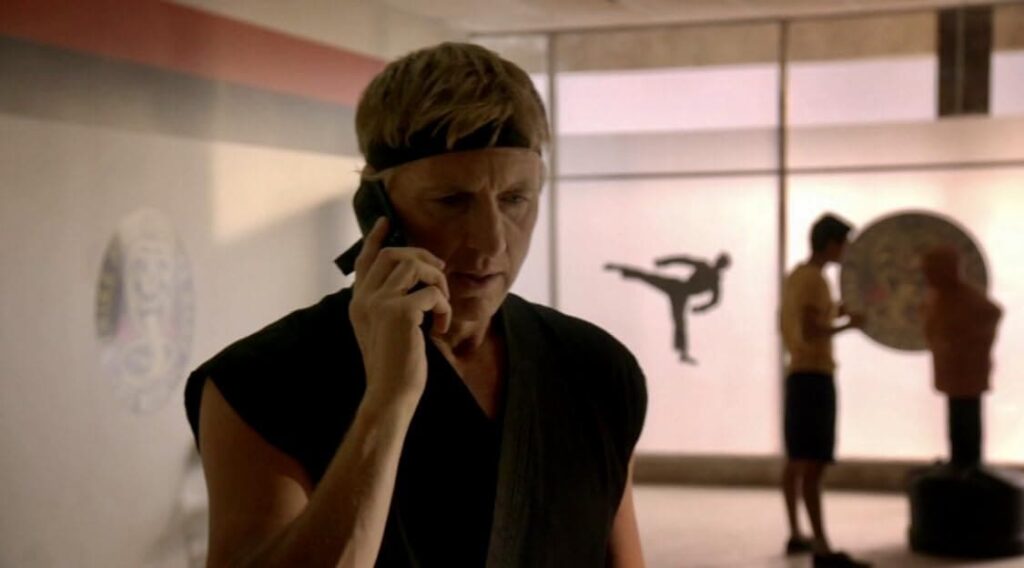
Character Themes: Certain characters, particularly Johnny Lawrence and Daniel LaRusso, have distinct musical themes associated with them. These themes evolve and adapt to reflect the characters’ emotional states and narrative arcs. The music helps underscore the complexities of the characters and their respective journeys.
Mood Enhancement: The musical score plays a crucial role in setting the mood for various scenes. Whether it’s conveying tension during confrontations or adding emotional depth to character moments, the music serves as an effective tool in shaping the overall tone of the episode.
2. Sound Design:
Martial Arts Sound Effects: The sound design during martial arts sequences is detailed and impactful. From the swishes of punches and kicks to the thuds of impact, the sound effects contribute to the realism of the fight scenes. These elements enhance the visual storytelling, making the action more immersive for the audience.
Flashback Audio Treatment: The use of distinct audio treatments during flashback sequences helps differentiate them from the present-day narrative. This could include changes in ambient sounds, echoes, or subtle alterations in the audio mix. These choices contribute to the seamless integration of past and present storytelling.
Environmental Sounds: The sound design incorporates environmental sounds to enhance the authenticity of different settings. Whether it’s the bustling sounds of a school hallway or the echoes within the Cobra Kai dojo, these environmental sounds contribute to the overall world-building and immerse the audience in the various locations.
Emotional Resonance: Sound design is employed to amplify emotional beats and character interactions. Subtle cues, such as the rustling of leaves or the creaking of a door, can add layers to the storytelling, emphasizing the emotional nuances of a scene.
Tension Building: The sound design works in tandem with cinematography to build tension during key moments, such as the encounter between Johnny and Daniel at the school. The use of suspenseful sounds or a well-timed absence of music contributes to the overall effectiveness of these scenes.
In conclusion, the music and sound design in Episode 2 of “Cobra Kai” Season 1 play a crucial role in enhancing the storytelling experience. Nostalgic themes, dynamic action scores, character-specific motifs, detailed sound effects, and thoughtful audio treatments during flashbacks contribute to the series’ immersive and emotionally resonant auditory landscape. The synergy between visual and auditory elements creates a holistic viewing experience for the audience.
Pacing and Episode Structure
“Cobra Kai” Episode 2 of Season 1, titled “Strike First,” showcases effective pacing and a well-structured episode, balancing character development, action sequences, and the advancement of the overarching narrative.
1. Pacing:
Dynamic Opening: The episode starts with a dynamic sequence as Johnny attempts to resurrect the Cobra Kai dojo. This opening sets the pace for the episode, immediately engaging the audience with Johnny’s struggles and the challenges he faces in bringing back the martial arts school.
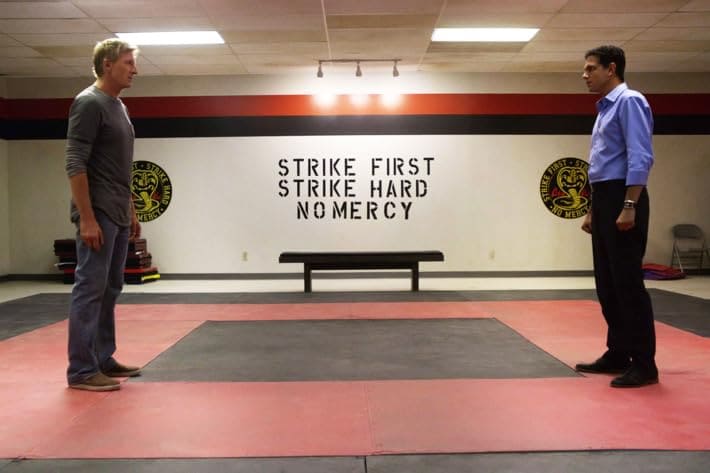
Flashbacks Integration: The use of flashbacks is seamlessly integrated into the narrative without disrupting the pacing. These glimpses into Johnny’s past are strategically placed, providing context for his character without slowing down the overall momentum of the episode.
School Fight Sequence: The pacing accelerates during the school fight sequence, adding a burst of energy to the episode. The action is well-timed, keeping the audience invested in the outcome while also advancing the plot and showcasing the consequences of the “strike first” philosophy.
Character Moments: Pacing is carefully managed during character moments, allowing for emotional beats to resonate. Scenes involving Johnny’s reflection on the past or Daniel’s concerns as a parent are given the necessary time to unfold, contributing to the depth of character development.
Tension-Building Encounters: The pacing excels in building tension, particularly during the encounters between Johnny and Daniel. The gradual escalation of these moments adds suspense and anticipation, keeping the audience hooked and invested in the rekindling rivalry.
2. Episode Structure:
Parallel Storytelling: The episode follows a structure that weaves together parallel storylines, seamlessly transitioning between Johnny and Daniel’s present-day struggles and their teenage years. This structure enhances the narrative complexity, emphasizing the cyclical nature of their lives and the enduring impact of their pasts.
Cohesive Flashbacks: Flashbacks are integrated cohesively, serving as interludes that provide insight into Johnny’s character. Rather than disrupting the flow, these flashbacks enhance the episode’s structure by offering a layered understanding of the protagonist’s motivations and challenges.
Conflict Resolution: The episode structure allows for the resolution of conflicts introduced in the previous episode while introducing new challenges. The resolution of Miguel’s bullying situation and the escalation of tensions between Johnny and Daniel contribute to a sense of narrative progression, maintaining a balance between resolution and ongoing conflicts.
Character Arc Advancement: Each character’s arc is advanced within the episode structure. Johnny’s attempts to rebuild Cobra Kai, Daniel’s reflections on mentorship, and Miguel’s journey as a student all progress organically, contributing to the overall development of the characters and the series.
Cliffhanger Element: The episode structure incorporates a cliffhanger element in the form of the rekindled rivalry between Johnny and Daniel. This strategic placement of conflict sets the stage for future episodes, leaving the audience eager to see how these dynamics will unfold.
In summary, Episode 2 of “Cobra Kai” Season 1 demonstrates effective pacing and a well-structured episode. The dynamic opening, seamless integration of flashbacks, well-timed action sequences, and strategic tension-building moments contribute to a compelling viewing experience. The episode structure successfully balances character development with advancing the overarching narrative, laying the foundation for the themes and conflicts that will unfold in subsequent episodes.
Fan Appeal and Easter Eggs
“Cobra Kai” Episode 2 of Season 1, titled “Strike First,” caters to fan appeal through nostalgic callbacks, Easter eggs, and references to the original “Karate Kid” film, creating a sense of continuity and delight for long-time fans while also offering enjoyable discoveries for new viewers.
1. Nostalgic Callbacks:
Cobra Kai Dojo: The episode opens with Johnny Lawrence attempting to resurrect the Cobra Kai dojo, bringing fans back to a familiar setting from the original “Karate Kid” film. The revisit to the iconic location serves as a powerful nostalgic callback for fans of the franchise.
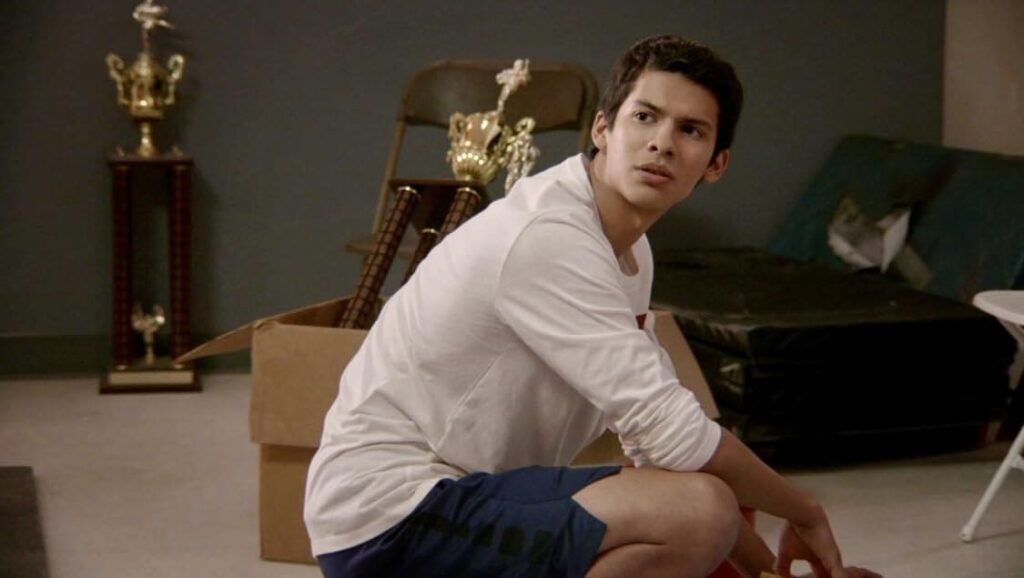
Flashbacks to Johnny’s Teenage Years: The use of flashbacks provides glimpses into Johnny’s teenage years, recreating scenes from the original movie. This deliberate nod to the past not only adds depth to Johnny’s character but also appeals to fans who appreciate the connection to the source material.
Cultural References: Throughout the episode, there are subtle references to 1980s pop culture, including music and fashion choices. These references contribute to the overall nostalgic atmosphere, resonating with viewers who have fond memories of that era.
2. Easter Eggs:
Old Cobra Kai Sign: When Johnny visits the old Cobra Kai dojo, viewers can spot the weathered and deteriorating Cobra Kai sign from the past. This Easter egg serves as a visual cue, symbolizing the passage of time and the dojo’s legacy.
Miyagi-Do Karate: The absence of Mr. Miyagi is subtly referenced, underscoring the impact of his mentorship on Daniel LaRusso. This Easter egg pays homage to the late Pat Morita’s iconic character and reinforces the connection between the two series.
School Trophy Case: During the school scenes, there are glimpses of the school’s trophy case, which includes references to events from the original “Karate Kid” film. This Easter egg adds a layer of authenticity to the school setting and rewards fans who pay attention to the details.
3. Fan Appeal Elements:
Character Reintroduction: The reintroduction of Johnny Lawrence and Daniel LaRusso, played by original actors William Zabka and Ralph Macchio, is a major fan appeal element. Seeing these characters reprised by the original actors adds authenticity and nostalgia to the series.
Martial Arts Sequences: The well-choreographed martial arts sequences, reminiscent of the original film, cater to fans who enjoyed the action elements of “The Karate Kid.” The series maintains the spirit of the martial arts genre, providing a familiar and satisfying experience for fans of the franchise.
In summary, Episode 2 of “Cobra Kai” Season 1 carefully incorporates fan appeal elements and Easter eggs, creating a tapestry of references that connect the series to its beloved source material. The nostalgic callbacks, subtle nods to the past, and intentional references contribute to the overall fan experience, making “Strike First” not only a continuation of the story but a celebration of the “Karate Kid” legacy.
Overall Enjoyment and Recommendation
“Cobra Kai” Episode 2 of Season 1, titled “Strike First,” offers a highly enjoyable viewing experience, balancing nostalgia with fresh storytelling, well-executed action sequences, and compelling character development. The episode’s engaging narrative and fan-pleasing elements make it a strong contender for recommendation.
1. Nostalgia and Continuity:
Seamless Integration of Past and Present: The episode adeptly weaves together flashbacks from the original “Karate Kid” film with the present-day narrative. This seamless integration allows both long-time fans and new viewers to appreciate the continuity of the story while introducing new layers to the characters.
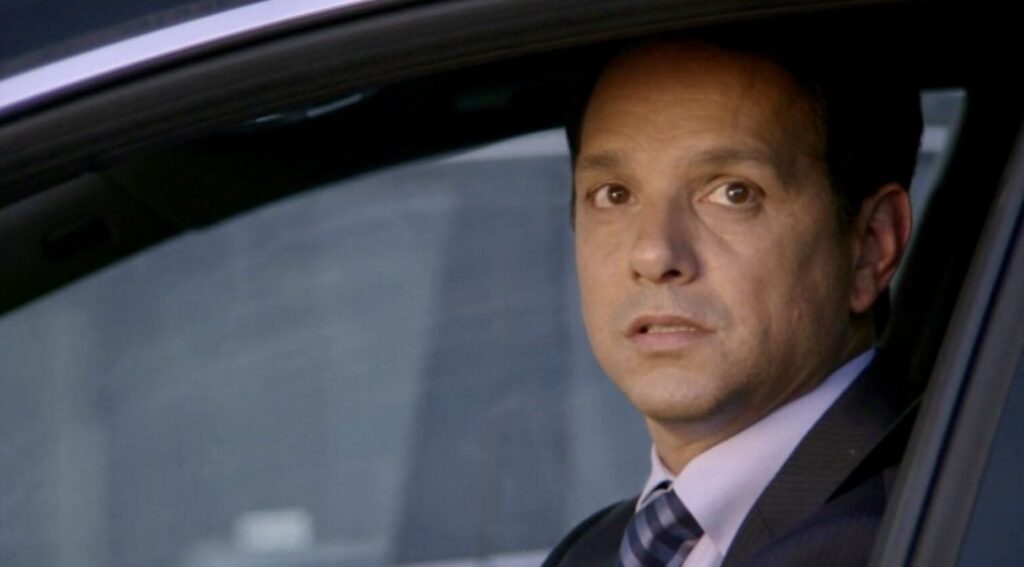
Iconic Locations and Themes: The revisit to the Cobra Kai dojo and the incorporation of familiar themes from the original movie evoke a strong sense of nostalgia. For fans of the franchise, these elements contribute to the overall enjoyment by reconnecting them to the beloved world of “The Karate Kid.”
2. Character Development:
Nuanced Portrayal of Characters: Episode 2 delves deeper into the characters of Johnny Lawrence and Daniel LaRusso, providing nuanced portrayals that go beyond their high school personas. This character development adds depth to the narrative, making it more engaging and allowing viewers to empathize with the struggles and motivations of the protagonists.
Moral Ambiguity: The exploration of the “strike first” philosophy introduces moral ambiguity, questioning the ethical implications of martial arts teachings. This adds complexity to the characters and the storyline, prompting viewers to reflect on the nature of right and wrong within the context of the series.
3. Action Sequences:
Well-Choreographed Fights: The episode features well-choreographed martial arts sequences that add excitement and dynamism to the storytelling. The action is not only visually engaging but also serves as a testament to the series’ commitment to delivering authentic and compelling fight scenes.
Empowerment Theme: The “strike first” philosophy, introduced through Johnny’s teachings to Miguel, adds a layer of empowerment to the narrative. This theme resonates with viewers, especially those who appreciate the empowerment narrative present in the original “Karate Kid” film.
4. Fan Engagement and Easter Eggs:
Nods to the Original Film: The inclusion of Easter eggs and nods to the original film enhances fan engagement. Recognizing elements like the old Cobra Kai sign and references to past events in the school trophy case adds an extra layer of enjoyment for fans familiar with the source material.
Rekindling Rivalry: The rekindling of the rivalry between Johnny and Daniel serves as a captivating hook for viewers, promising future conflicts and character dynamics. This element keeps fans invested in the ongoing narrative and eager to see how the rivalry will unfold.
5. Recommendation:
Broad Appeal: The episode’s ability to balance nostalgia with fresh storytelling makes it suitable for both fans of the original “Karate Kid” franchise and new viewers. The series intelligently caters to a broad audience, making it accessible and enjoyable for various demographics.
Continued Engagement: The strong narrative, character development, and action sequences set a positive tone for the series, encouraging viewers to continue watching. The episode lays the groundwork for future conflicts and resolutions, creating anticipation and interest in subsequent episodes.
In summary, Episode 2 of “Cobra Kai” Season 1 is likely to be highly enjoyable for both fans and new viewers. Its seamless integration of past and present, well-developed characters, engaging action sequences, and nods to the original film contribute to a compelling viewing experience. The overall appeal and quality of the episode make it a strong recommendation for those seeking an entertaining blend of nostalgia and contemporary storytelling.
